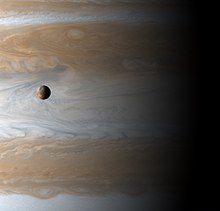User:Ryan.mi/sandbox
Creating page transit (astronomy) for Simple English Wikipedia. Work in progress. _________________________________________________________________________________________________________________

In the science of astronomy, the study of outer space, a transit or astronomical transit is the event that occurs when someone sees one astronomical object, like a planet, pass in front of another larger one, like a star. The small object hides a part of the large object from the viewer.
Definition[edit]
The word transit refers to an event where an astronomical object passes in front of a larger one. If a large object passes in front of a smaller one, and if most or all of the smaller object can not be seen, the event is called an occultation.
A transit can only occur if the viewer and both of the bodies are all in a straight line. Within the Solar System, viewers from Earth can see only two planets transit the Sun. These two planets are Venus and Mercury. From Earth one can also see moons passing their parent planet. For example, from Earth it is possible to see one of the moons of Jupiter, like Io, transit Jupiter itself. It is also possible to see a planet from outside the solar system, called an exoplanet, transiting its own star.
Transits of Mercury and Venus[edit]
From Earth, the only two planets in the Solar System that can be seen transiting are Mercury and Venus. These events occurs in cycles, and astronomers can predict when the next transits will be.
Transits of Venus occur in a pattern that lasts 243 years. Two transits occur within 8 years of each other, and the other two are 105.5 years and 121.5 years apart. The first observed transit of Venus was viewed on December 4th, 1639 by Jeremiah Horrocks[1]. Measurements taken from this were used to guess the size of Venus and the distance from the Earth to the Sun. The most recent transits were on June 8th, 2004 and June 5th, 2012. The next transit of Venus will occur on December 10th, 2117.
Transits of Mercury occur more often than transits of Venus. They happen near November 10th every 7, 13 and 33 years and near May 8th every 13 and 33 years. The first observation of a transit of Mercury was on November 7th, 1631 by Pierre Gassendi. The most recent transits occurred on May 7th, 2003 and November 8th, 2006. The next transit will occur on May 9th, 2016.[2]
Transits of Planets outside the Solar System[edit]

Current telescopes are powerful enough to observe planets outside the solar system transiting other stars. If there is enough knowledge available about the star, the observation of the transit can be used find a new planet. Astronomers can look at a star and record what type of light it gives off, in terms of factors such as brightness and color. When a planet passes in front of the star, the light from the star changes because the planet is blocking some starlight. The change causes the light we see to be different in color and brightness. By studying these differences, it is possible to learn about things like the planet's mass and radius, or size.[3] For example, a bigger planet blocks more starlight, so looking at how much light is blocked can help astronomers learn the planet's radius.
Observing an exoplanet in transit and studying the changes in the starlight can also help astronomers guess what the planet's atmosphere might be made up of. During a transit, starlight that hits the planet itself is blocked, but some starlight passes through the gases just above the planet. The different types of gases in the atmosphere each leave a mark on the starlight. Scientists can use spectroscopy to find out what the different gases are, and which one is the most common.
The Kepler space observatory has discovered more than 2,740 potential planets by observing transits.[4]. Scanning large areas of the sky and checking stars there for transits, the transit method of planet detection may become the fastest way to discover new planets. [5] The first planet discovered this way was HD 209458b.[6].
Problems with Finding Planets with Transits[edit]
However, trying to find planets by looking for transits has downsides. Because a transit event only occurs when a planet is in a straight line with the star and the Earth, only some planets can be find. Some planets do not ever pass in front of the star when look at from Earth, so these planets couldn't be found this way. Also, data suggests that nearly 35% of planets detected with this method in the Kepler mission may be false positives.[7] [8] That is, 35% of the discovered planets might not exist at all. This is because the telescope was could be confused by binary stars, stars that go around one another. Sometimes, one star would just barely pass in front of the other. This would change the light from the stars like a transit would, but without there being a planet. Finding out the chance of a planet being a false positive is the next step toward learning what planets really exist.[9]
See also[edit]
References[edit]
- ^ "William Crabtree’s Venus transit observation", Kollerstrom, Science and Technology Studies Department, University College London, 2004 [1]
- ^ "Planetary Transits Across the Sun", NASA.gov, 2012 Feb. 24, [2]
- ^ "Homogeneous studies of transiting extrasolar planets",Southworth,Mon. Not. R. Astron. Soc. 408, 1689–1713 (2010) [3]
- ^ NASA's Kepler Mission Discovers 461 New Planet Candidates, Johnson, NASA.gov, 7 January 2013 [4]
- ^ "The UNSW Extrasolar Planet Search", Hildas, 2005[5]
- ^ "DETECTION OF PLANETARY TRANSITS ACROSS A SUN-LIKE STAR", Charbonneau, L45 The Astrophysical Journal, 529:L45–L48, 2000 January 20 http://home.strw.leidenuniv.nl/~vdburg/MO_files/Charbonneau%202000%20ApJ.pdf]
- ^ "SOPHIE velocimetry of Kepler transit candidates", Santerne, Astronomy & Astrophysics Volume 545, September 2012 [6]
- ^ "Extrasolar planets: Astrophysical false positives", A. Cameron, Nature 492,48–50, (06 December 2012), doi:10.1038/492048a[7]
- ^ " An Efficient Automated Validation Procedure for Exoplanet Transit Candidates", Morton, T. D. Preprint (2012).[8]

